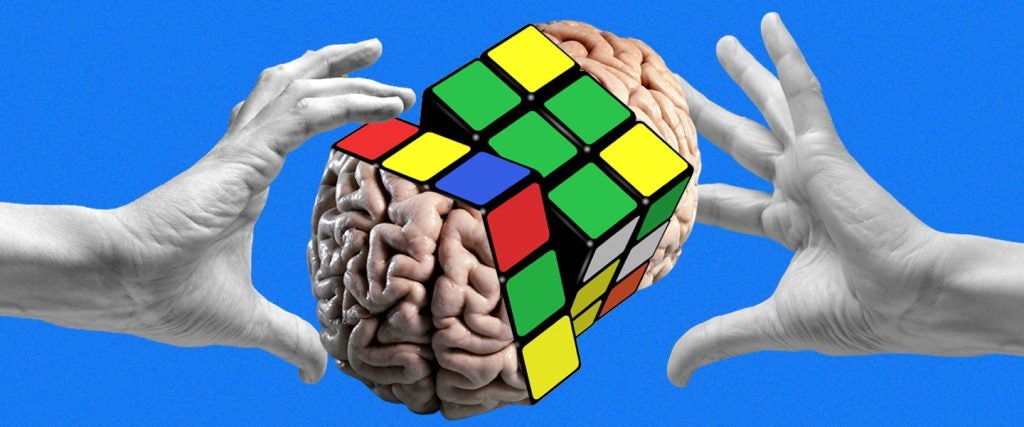I’ve never solved a Rubik’s Cube, and there’s a decent chance I never will. My six-year-old daughter has one, and once in a while, she rediscovers it in her playroom and asks me if I know how to “fix” it. I say “no,” and then it goes back in the toybox until the pattern repeats itself. Usually, it doesn’t bother me — I just never had the time, patience or interest to sit down with a Rubik’s Cube for more than a few minutes — but sometimes I wonder if my lack of cube-solving means I’m an idiot. After all, in movies, if a character solves a Rubik’s Cube, that pretty much guarantees they’re a genius.
But does that actually hold up? And how smart do you have to be to solve a Rubik’s Cube, anyway?
Just googling the query didn’t really get me anywhere. I learned about the origins of the Rubik’s Cube — it was invented in 1974 by Hungarian architecture professor Ernő Rubik — and how it eventually became an American craze in the 1980s. I also discovered that the Rubik’s Cube wasn’t just some rinky-dink toy from yesteryear, but that there’s a whole community of people obsessed with it — they’re called “Cubers.” There are even international competitions where people solve the Rubik’s Cube in less than five seconds.
In the forums and Reddit threads I explored, many Cubers insisted that you don’t have to be a genius to solve a Rubik’s Cube, and that anyone can learn how. That may well be true, but I also found a number of complex scientific algorithms written by computer scientists breaking down how the cube can be solved.
So again, which is it? Do you need to be a genius, or a computer, or a computer genius to solve this thing? Or can any moron do it?
I posed the question to a few Cubers, as well as a mathematician and a couple of computer scientists. The most prominent person I spoke to on the matter was computer-engineering professor Jessica Fridrich from Binghamton University, who created what’s known as the “Fridrich Method” of Rubik’s Cube solving (this is the method by which most speedcubers, as they’re called, solve the cube). “It depends how you measure smartness,” Fridrich tells me. “You can see little kids doing it. These kids have no formal education in math — they can barely read and write — and they can do this. So I think you need good common sense and an innate intelligence that you’re born with.”
For his part, Ethan Pride, chair of the World Cube Association, says that to solve a Rubik’s Cube, you don’t have to be smart at all. “It’s really easy to learn, and I’ve taught a lot of people how to do it,” he says. “Some I’d consider to be smarter, and others are far from the genius you’d picture when you think of a Rubik’s Cube solver in a movie.” That said, he insists that it must be learned, either through trial-and-error or from others — you can’t just stumble upon a solution. “Anyone who’s told me that they turned it randomly for two days and solved it isn’t telling the truth,” he says. “You can’t accidentally solve a Rubik’s Cube.”
But while practically anyone can learn to solve it, Ian Scheffler, author of Cracking the Cube, is quick to distinguish the difference between solving the puzzle entirely on your own and learning to solve it from others on YouTube and the like. “To figure out your own solution with no one telling you how, you have to be really smart, and that takes some serious brains,” he says. “But anyone can learn it with the help of YouTube.”
Pretty much all cubers learn from each other, though, so does that taint the pool enough so that high-level cube-solving in no way reflects intelligence? Pride doesn’t think so. “To solve it, it’s not that hard. To solve it in under a minute, that’s also not that hard. But when you get to the world-class speedcubers, they have a different view on how the pieces are moving,” he says. “Most people, myself included, can see where a piece is, but can’t see where it will end up after a certain set of moves. But for the people who can complete the cube in a few seconds, they’ll know the moves they’re going to do, and they’ll know where to expect that piece to end up.”
Pride says that that kind of strategy, spatial awareness and dexterity does take quite a bit of intelligence and problem-solving, and that he sees this reflected at the highest levels of speedcubing.
Fridrich agrees: “The record time for solving a cube is about 3.5 seconds and the average time at these competitions is about five seconds. For people who are solving the cube at that level, many of them go on to promising careers in technology, mathematics, engineering or artificial intelligence.”
So, at the very least, there seems to be a correlation between high-level speedcubing and one’s level of intelligence, particularly in STEM fields. Most of all, though, Fridrich insists that dedication is the key. “You don’t have to be super-smart,” she reiterates. “I think you just have to be dedicated. You either find the cube interesting, or you don’t. If you don’t find it interesting, you won’t be motivated to do it. It’s like a possession, you have to get possessed by the cube and have a need to solve it. And if you become possessed by it, you can solve it.”
Personally speaking, I have yet to become possessed by that little cube, and until I do, it’ll likely remain at the bottom of my daughter’s toybox, completely scrambled until I become motivated enough to solve it. That, or I’ll just sell it in a yard sale — that will teach that snide little cube to insult my intelligence!

